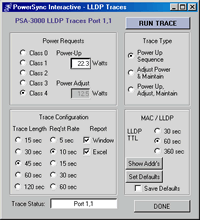802.3at LLDP Emulation and Analysis
Link Layer Discovery Protocol Emulation and Analysis

802.3at LLDP Emulation and Analysis
With the 802.3at standard, PoE has moved in the direction of bypassing layer 1 PD classification in favor of a MAC (or Link) Layer PD classification that offers very high power distribution granularity and enables dynamic negotiation of power levels between PSE and PD
The link layer scheme uses a PoE-specific Link Layer Discovery Protocol (LLDP) as specified in the new Clause 79 of IEEE 802.3 with additional protocol rules defined in Clause 33 (IEEE 802.3at). LLDP is a link (point-to-point) MAC protocol historically used to allow switches and routers to automatically “discover” what is around them and to populate and maintain a MIB that can be used for viewing and managing a network topology.
PSA-3000 Family: LLDP Emulation and Analysis
PSA-3000 and PSL-3000 platforms each offer a feature upgrade that enables flexible emulation and analysis for PoE "Plus" LLDP. The upgrade is available in the form of an instrument-specific license code that may be purchased from Sifos Technologies.
LLDP Emulation involves modeling numerous characteristics of a PD as it uses LLDP to request and agree upon power allocations from a PSE. Normally, such transactions are performed immediately after powering the PD, though they may be ongoing with subsequent power adjustments induced by either the PD or the PSE. Characteristics that may be modeled are PD Power Request, PSE Power Allocation (echo), periodicity of packet transmission, timing of responses to value changes, LLDP time-to-live, and various TLV fields that communicate device status and information
LLDP Analysis involves capturing and analyzing bi-directional PoE-specific LLDP packets and associated packet timing during PD power-ups and during ongoing (post power-up) power adjustments.
The PSA-3000 and PSL-3000 platforms support flexible LLDP Emulation and robust LLDP Analysis capabilities that are accessible from both PSA Interactive (GUI) and PowerShell PSA. LLDP power-up emulations to target power requests are performed in a single "button-click" in PSA Interactive or a single command in PowerShell PSA. LLDP Protocol Traces offer fully automated capture, display, and analysis of LLDP protocol sequences between a PSE port and a user-defined PD. Analysis is performed in colorful pop-up Excel spreadsheets that highlight protocol non-conformances or timing defects.
LLDP and the PSE Conformance Test Suite for 802.3at
PSA version 3.5 software adds the new class_lldp PSE Conformance Test to the evolving 802.3at Conformance Test suite. This test assesses PSE conformance to LLDP-specific PIC's items in the 802.3at standard.
LLDP emulation will be a common feature of Type-2 (30W) power-ups in many of the tests that require powered ports given that the PSE-under-test utilizes LLDP to perform power "grants" beyond 13 watts. PSA 3.5 software includes all of the underpinnings to enable future PSE Conformance Tests to run with either 2-Event ("PHY") power grants or LLDP power grants
In-Depth LLDP Emulation Control
Using PowerShell PSA, even greater control of LLDP emulations and associated LLDP testing is made possible through a full set of PowerShell API commands. Received PSE packets may be analyzed for "raw" LLDP content. PD Request packets may be configured for various content including MAC address, TTL, and all PoE Plus fields including invalid power requests. PD Request packet timing relative to incoming PSE packets can be precisely controlled. PSE LLDP packets may be emulated as might be useful for script development or testing PD's.
LLDP Emulation and Analysis datasheet